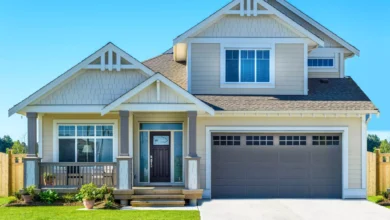🏡 Wildfire Defense Strategies for Homeowners in USA (2025)

With 2025 marking one of the most intense and destructive wildfire seasons in American history, homeowners across the U.S. are increasingly looking to proactive defenses. Implementing wildfire defense strategies 2025, incorporating fire-resistant home features, and following a solid wildfire safety checklist for homeowners are no longer optional—they are essential.
🔥 1. Understand the Wildfire Threat
In early 2025, regions like Southern California, Oregon, and Colorado saw wildfires that burned millions of acres and damaged thousands of homes . These blazes spread quickly, fueled by a combination of climate‑driven heat, drought, and ember-driven ignition. One standout survivor was the Getty Villa—its defensive design and building materials showcased how effective preparedness measures can be businessinsider.com.
🛡️ 2. Top Wildfire Defense Strategies 2025
a. Create Defensible Space Zones (0–100 ft)
Implement the wildfire safety checklist for homeowners by establishing defensible space:
- Zone 0 (0–5 ft): Remove combustible materials, mulch, and flammable landscaping. Use fire-resistant features like gravel or stone pathways businessinsider.com+7forestry.com+7coveragecat.com+7.
- Zone 1 (5–30 ft): Maintain lean, clean, and green landscape—trim vegetation, prune trees 6 ft above ground, and space shrubs 10 ft apart climatecheck.com+11bhg.com+11coveragecat.com+11.
- Zone 2 (30–100 ft): Thin out fuels, remove ladder fuels, and create firebreaks with gravel or driveways coveragecat.com.
These zones not only slow wildfire progression but also improve firefighter access.
b. Install Fire-Resistant Home Features
Home hardening is critical:
- Roof & Gutters: Use Class‑A fire-rated roofing—metal, tile, or treated asphalt shingles. Install gutter guards to prevent ember buildup coveragecat.com+1reddit.com+1climatecheck.com+10chubb.com+10rollingout.com+10.
- Exterior Walls & Siding: Choose non-combustible materials—fiber cement, stucco, brick, or stone veneer ikkonic.com+9chubb.com+9probuilder.com+9.
- Windows & Doors: Install dual-pane or tempered-glass windows, reinforced doors with spark arresters rollingout.com+3nachi.org+3nationwideexcessandsurplus.com+3.
- Vents, Eaves, and Soffits: Cover openings with 1/8″ or finer metal mesh; box in soffits to block embers en.wikipedia.org+10chubb.com+10coveragecat.com+10.
These are essential fire-resistant home features that can reduce ignition risk by over 90% in lab tests en.wikipedia.org+15coveragecat.com+15rollingout.com+15.
c. Firescaping Your Landscape
Adopt “firescaping”—smart landscaping that defends as it beautifies:
- Use non-combustible hardscape materials like gravel and rock.
- Select low‑fuel native plants (e.g., lavender, succulents) for aesthetics and defensibility nationwideexcessandsurplus.com+3bhg.com+3en.wikipedia.org+3.
- Maintain spacing between plants and prune regularly bhg.com+1forestry.com+1.
d. Emergency Preparedness & Checklists
A crucial component of the wildfire safety checklist for homeowners is readiness:
- Prepare evacuation plans with routes and meeting locations.
- Assemble kits with essentials—documents, water, medication, pet supplies ikkonic.com+8primeis.com+8rollingout.com+8.
- Pre-monitor fire alerts via local systems and the FEMA app.
🌳 3. Community Strategies: Fire-Adapted Neighborhoods
Communities that work together dramatically improve resilience. This includes:
- Forming Fire Safe Councils to coordinate fuel reduction efforts time.com+4en.wikipedia.org+4bhg.com+4.
- Adhering to IBHS Wildfire-Ready or Firewise USA standards across multiple homes wfca.com+8coveragecat.com+8nypost.com+8.
- Implementing collaborative community defensible zones and evacuation systems.
The Getty Villa stands as a prime example—widely spaced homes, Class A materials, and a 30-foot defensible zone saved it from destruction businessinsider.com.
🏠 4. What to Include in Your Wildfire Safety Checklist for Homeowners
Use this as a ready reference:
- Regular debris removal from roofs, gutters, patios
- Inspect Class A roofing yearly
- Ensure vents, soffits, and eaves are screened
- Check and reinforce window/door seals
- Maintain 0–5 ft non-combustible zone
- Create trimmed, hydrated zone 5–30 ft
- Thin vegetation 30–100 ft, remove ladder fuels
- Install external sprinkler systems
- Create emergency evacuation plan & kit
- Stay informed and connected to community alerts
These steps align with FEMA, NFPA Firewise, and IBHS guidelines.
🌎 5. Why These Strategies Matter in 2025
- Homes equipped with Class‑A roofs, ember‑resistant vents, and dual-pane windows reduce ignition rates by 90% wfca.com+3forestry.com+3chubb.com+3primeis.com+6coveragecat.com+6ikkonic.com+6en.wikipedia.orgnationwideexcessandsurplus.comrollingout.com+1forestry.com+1.
- Landscaped defensible zones significantly slow wildfires and increase home survival chances .
- Community mitigation efforts not only protect homes but can also help maintain affordable homeowners insurance in high-risk state insurance rates and improve access .
📲 6. Final Thoughts
As wildfires escalate in intensity and frequency, wildfire defense strategies 2025 must become standard. Integrating fire-resistant home features with a robust wildfire safety checklist for homeowners builds readiness and confidence.
Backing your defenses with community coordination and smart policy awareness—such as checking state-run insurance plans for high-risk homes—will give you the best chance to protect both your property and your peace of mind.
🔗 Resources & Further Reading
- IBHS Wildfire Prepared Home Program: firestrategies.org
- FEMA Wildfire Defense: ready.gov/wildfires
- NFPA Firewise USA: firewise.org
- California Defensible Space Plans: readyforwildfire.org
- Oregon wildland-urban interface mapping and code updates coveragecat.com+1probuilder.com+1nationwideexcessandsurplus.com




